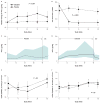Salicylate (salsalate) in patients with type 2 diabetes: a randomized trial
- PMID: 23817699
- PMCID: PMC4128629
- DOI: 10.7326/0003-4819-159-1-201307020-00003
Salicylate (salsalate) in patients with type 2 diabetes: a randomized trial
Abstract
Background: Short-duration studies show that salsalate improves glycemia in type 2 diabetes mellitus (T2DM).
Objective: To assess 1-year efficacy and safety of salsalate in T2DM.
Design: Placebo-controlled, parallel trial; computerized randomization and centralized allocation, with patients, providers, and researchers blinded to assignment. (ClinicalTrials.gov: NCT00799643).
Setting: 3 private practices and 18 academic centers in the United States.
Patients: Persons aged 18 to 75 years with fasting glucose levels of 12.5 mmol/L or less (≤225 mg/dL) and hemoglobin A1c (HbA1c) levels of 7.0% to 9.5% who were treated for diabetes.
Intervention: 286 participants were randomly assigned (between January 2009 and July 2011) to 48 weeks of placebo (n = 140) or salsalate, 3.5 g/d (n = 146), in addition to current therapies, and 283 participants were analyzed (placebo, n = 137; salsalate, n = 146).
Measurements: Change in hemoglobin A1c level (primary outcome) and safety and efficacy measures.
Results: The mean HbA1c level over 48 weeks was 0.37% lower in the salsalate group than in the placebo group (95% CI, -0.53% to -0.21%; P < 0.001). Glycemia improved despite more reductions in concomitant diabetes medications in salsalate recipients than in placebo recipients. Lower circulating leukocyte, neutrophil, and lymphocyte counts show the anti-inflammatory effects of salsalate. Adiponectin and hematocrit levels increased more and fasting glucose, uric acid, and triglyceride levels decreased with salsalate, but weight and low-density lipoprotein cholesterol levels also increased. Urinary albumin levels increased but reversed on discontinuation; estimated glomerular filtration rates were unchanged.
Limitation: Trial duration and number of patients studied were insufficient to determine long-term risk-benefit of salsalate in T2DM.
Conclusion: Salsalate improves glycemia in patients with T2DM and decreases inflammatory mediators. Continued evaluation of mixed cardiorenal signals is warranted.
Conflict of interest statement
Figures




Summary for patients in
-
Summaries for patients. Salsalate for type 2 diabetes mellitus.Ann Intern Med. 2013 Jul 2;159(1):I-32. doi: 10.7326/0003-4819-159-1-201307020-00001. Ann Intern Med. 2013. PMID: 23817718 No abstract available.
References
-
- Jack DB. One hundred years of aspirin. Lancet. 1997;350:437–9. - PubMed
-
- MacLagan TJ. The treatment of acute rheumatism by salicin. Lancet. 1876;107:342–3. 383–4. - PubMed
-
- Broadbent WH. Treatment of rheumatic fever by salicylic acid. Lancet. 1876;107:530–2.
-
- Mann CC, Plummer ML. The Aspirin Wars: Money, Medicine and 100 Years of Rampant Competition. Boston: Harvard Business School Pr; 1991.
-
- Loll PJ, Picot D, Garavito RM. The structural basis of aspirin activity inferred from the crystal structure of inactivated prostaglandin H2 synthase. Nat Struct Biol. 1995;2:637–43. - PubMed
Publication types
MeSH terms
Substances
Associated data
Grants and funding
LinkOut - more resources
Full Text Sources
Other Literature Sources
Medical
